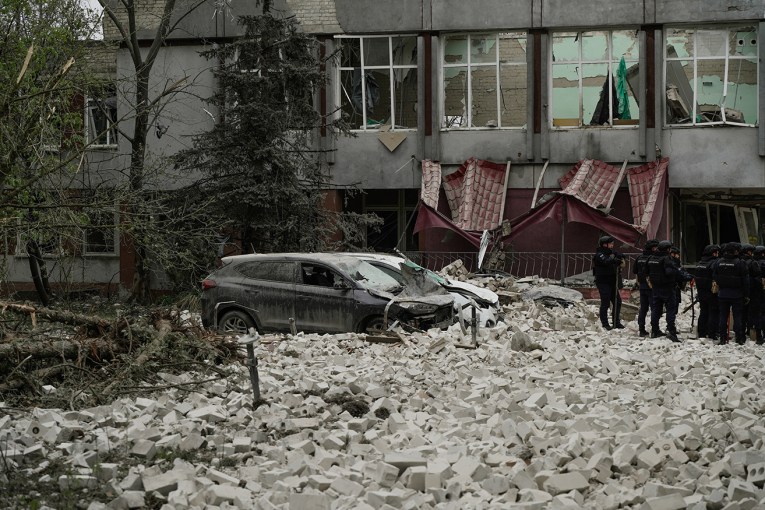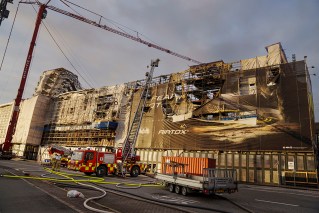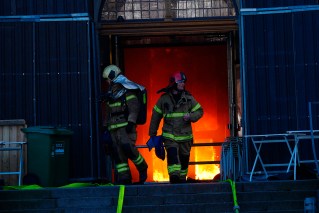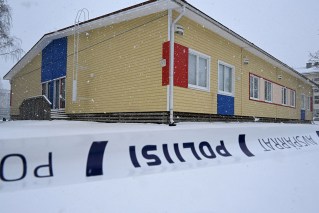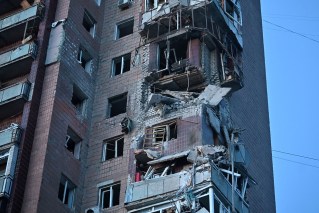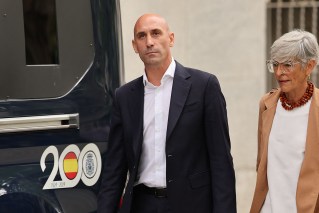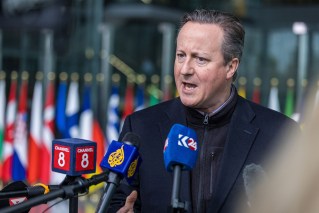Photos emerge of sinking Russian flagship

Images have emerged showing a key Russian warship badly damaged and burning in the hours before it sank last week.
The Moskva, a missile cruiser considered the flagship of Russia’s Black Sea fleet, sank last Thursday.
Ukraine forces claimed it was hit by their missiles, but Russia claims the fire that led to its sinking was due to exploding ammunition on board.
It was Russia’s biggest wartime loss of a naval ship in 40 years – and a huge embarrassment for Moscow.
Images circulating on social media on Tuesday show the Moskva listing to one side, with black holes from possible missile puncture marks, and significant scarring at and just above the waterline on one side of the vessel.
A large plume of black smoke can be seen billowing upwards, partly obscuring the front of the stricken ship.
Analysts have said the vessel in the images looked like the Moskva, a Slava Class guided-missile destroyer.
Elsewhere, Ukraine on Tuesday that Russia had started an anticipated new offensive in the east of the country. Explosions have been reported all along the front lines as well as attacks in other regions.
Ukrainian President Volodymyr Zelensky said Russia had begun the “Battle of Donbas” in the east on Monday and a “very large part of the entire Russian army is now focused on this offensive”.
There are believed to be more than 50,000 Russian forces along a 4800-kilometre front line in the Donbas region.
“No matter how many Russian troops they send there, we will fight. We will defend ourselves,” Mr Zelensky vowed in a video address.
Mr Zelensky’s chief of staff, Andriy Yermak, called it “the second phase of the war” and assured Ukrainians their forces could hold off the offensive.
“Believe in our army, it is very strong,” he said.
Ukrainian media reported a series of explosions, some powerful, along the front line in the Donetsk region, with shelling in Marinka, Slavyansk and Kramatorsk.
Ukrainian local officials and local media also said explosions were heard in Kharkiv in the north-east of Ukraine, Mykolaiv in the south and Zaporizhzhia in the south-east.
Reuters was not immediately able to verify the reports.
Russia also struck many Ukrainian cities heavily at the weekend, believed to be revenge attacks for the Moskva sinking.
On Saturday, Russian rockets allegedly hit a military hardware factory in Kyiv’s Darnytskyi district.
“They are making us pay for destroying the Moskva,” Andrei Sizov, the 47-year-old owner of a nearby wood workshop, told AFP.
Ukraine’s top security official, Oleksiy Danilov, said Russian forces attempted to break through Ukrainian defences “along almost the entire front line of Donetsk, Luhansk and Kharkiv regions” on Monday (local time).
Driven back by Ukrainian resistance in the north, Moscow has refocused its ground offensive in the two eastern provinces known as the Donbas, while launching long-distance strikes at other targets including the capital, Kyiv.
Donbas has been the focal point of Russia’s campaign to destabilise Ukraine, which started in 2014 when the Kremlin used proxies to set up two separatist “people’s republics” in the ex-Soviet state. It is also home to much of Ukraine’s industrial wealth, including coal and steel.
Russia’s defence ministry said it had hit hundreds of military targets in Ukraine overnight.
Western capitals and Kyiv accuse Russian President Vladimir Putin of unprovoked aggression, and the White House said US President Joe Biden would hold a call with allies on Tuesday to discuss the Ukraine crisis, including on how to coordinate on holding Russia accountable.
The White House has said there are “no plans” for Mr Biden to travel to Kyiv.
French President Emmanuel Macron said his dialogue with Mr Putin had stalled after mass killings were discovered in Ukraine.
The United Nations said on Monday the war’s civilian death toll had reached 2072 as of midnight on April 17 from the start of the Russian invasion on February 24.
About four million Ukrainians have fled the country.
Russia denies targeting civilians in what it calls a special operation to demilitarise Ukraine and eradicate dangerous nationalists. It rejects what Kyiv says is evidence of atrocities, saying Ukraine has staged them to undermine peace talks.
Russia has been trying to take full control of the south-eastern port city of Mariupol, which has been besieged for weeks. It would be a huge strategic prize, linking territory held by pro-Russian separatists in the east with the Crimea region that Moscow annexed in 2014.
Video footage showed block after residential block in charred ruins. Shell-shocked residents in the Primorskyi district cooked on open fires outside their damaged homes.
The city council said at least 1000 civilians were still hiding in underground shelters beneath the vast Azovstal steel plant, which contains myriad buildings, blast furnaces and rail tracks.
Footage of women and children apparently sheltered in the steel plant was posted on Telegram late on Monday by the Azov Battalion, a unit that began as an ultra-nationalist militia but has since integrated into the Ukrainian armed forces.
The regiment’s commander, Lieutenant Colonel Denys Prokopenko, in Mariupol said Russian forces had been firing “willingly” on the Azovstal factory.
“Russian occupational forces and their proxy from Luhansk People’s Republic/Donetsk People’s Republics know about civilians and keep their fire on the factory willingly. They use free-fall bombs, rockets, bunker-buster bombs, and all varieties of artillery, both ground and naval, for indiscriminate attacks,” Colonel Prokopenko said.
Major Serhiy Volyna, commander of Ukraine’s 36th marine brigade which is still fighting in Mariupol, appealed for help in a letter to Pope Francis.
“This is what hell looks like on Earth … It’s time [for] help not just by prayers. Save our lives from satanic hands,” the letter said, according to excerpts tweeted by Ukraine’s Vatican ambassador.
-with AAP
